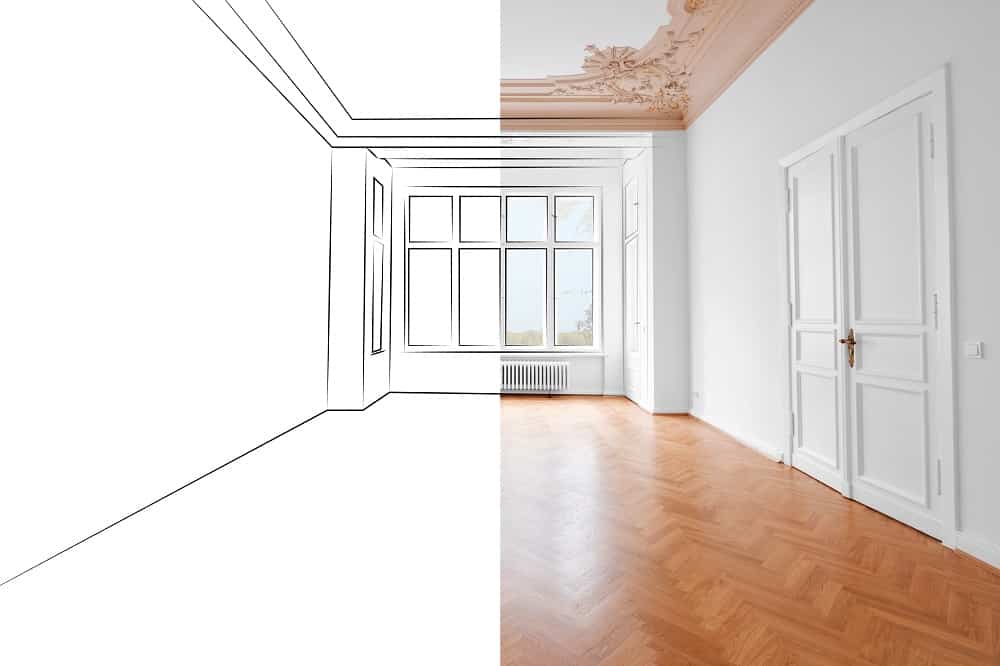While computer rendering is generally known to be a procedure wherein a computer system or network of computer systems are tasked with creating a visual image via the use of software and their own hardware power, there is a noted distinction between the particular types of rendering and their subsequent visual dimensions.
These distinct forms of end-product rendering projects are oftentimes differentiated not only by the method at which they are produced but also in the appearance of their final output, with three dimensional renderings oftentimes providing a more photorealistic and computed form as opposed to the still-frames of a two dimensional rendering.
Three dimensional rendering and two dimensional rendering are simply terms used to refer to the specific differences between two forms of rendering outputs, with factors such as point of view, power consumption, financial cost, speed of rendering and even the quality of the rendering being used to differentiate the two.
Table of Contents
What is 2D Rendering?

Two dimensional rendering, otherwise abbreviated to 2D rendering, is an end-product form of computer graphical generation wherein the point of view of which the image is seen from is static or otherwise stationary.
This means it cannot otherwise be rotated or viewed from an alternative angle without rendering it once more from this new perspective, essentially locking the audience into a single view of the scene.
Apart from this restriction in the angle at which the rendering is viewed, there is also the case of particular rendering techniques that are utilized, especially in concern to light subsurface scattering, reflective surfaces and light ray penetration or diffusion.
These effects are more often seen in three dimensional rendering products owing to the fact that they “trace” a line of light between three dimensional objects present in the rendering scene, something that is otherwise not possible in two dimensional renderings because of a lack of three dimensional space at which to bounce the light through.
While it is entirely possible to produce a two dimensional rendered frame from a three dimensional scene, it is often far less efficient and is most usually done as a proof of work concept or for use in examples provided to a client.
Asides from these factors, two dimensional rendering may also be differentiated from other forms of rendering by which the modelled or rendered assets present in the scene are created, with the relatively restricted point of view used in two dimensional rendering allowing the artist to use hand-drawn images or those taken with a camera in real life with very little noticeable difference.
This is especially so when two dimensional renderings are subjected to post-production effects, such as the use of photo manipulation software to mask any errors missed by the artist or to overcome current technological limitations.
What is 3D Rendering?

Three dimensional rendering, on the other hand, are renderings produced through computer graphical generation that mimic or replicate that of real life visual effects, with factors like multiple perspectives, animation and even photorealistic lighting all being hallmarks of quality three dimensional rendering work.
While three dimensional computer imaging uses much the same software, algorithms and techniques as two dimensional rendering, certain visual effects can only truly be applied to the aforementioned three dimensional renders, owing to the distinct nature of the three dimensional models used in a 3D scene and the visual implications that come with them.
However, this is not to say that both three dimensional and two dimensional renderings utilize entirely distinct rendering methods or the characteristics of these rendering methods.
In fact, three dimensional rendering often times also uses methods such as vector-based modelling and bitmap file type texture generation, both of which originated in two dimensional rendering methods.
The most immediately noticeable difference between a three dimensional rendering and that of a two dimensional rendering is the fact that the audiences perspective- otherwise referred to as the “camera”- may be moved around the scene freely, which is otherwise impossible in a two dimensional render because of its lack of a third directional dimension.
Apart from this, 2D rendering does not ordinarily utilize three dimensional modelling objects unless it is attempting to replicate certain lighting effects that are otherwise not possible with two dimensional models.
The process of creating a three dimensional model is much like sculpting a statue within a digital space wherein an artist or special effects engineer will use specialized modelling software in order to shape their desired object as close as possible to their vision.
This is not limited to simply shaping the model, however, as things such as phong angles, texture application, specularity maps and even animation skeleton rigging are all introduced using this three dimensional modelling process as well.
Where is 2D Rendering Used?
In the infancy of computer generated and processed graphical images, 2D rendering was primarily used in the hopes of creating a printable file that may be physically present in the real world, meant to be used in things such as billboards, stickers and even clothing design.
However, with the rapid advancement of technology and the subsequent shifting of consumer demands, two dimensional rendering began to take on a different purview, focusing on products primarily remaining in the digital space wherein they may take on the form of vector graphics, still scene renders and even digital raster artwork.
Two dimensional rendering is most often seen in the form of early video games or games that wish to replicate the type of aesthetic that was the upper technological limit at the time, taking on the shape of 2D sprites and raster graphics on a flat plane with a single point of view.
Two dimensional rendering may also be used in the form of cartoon animation or similar media that are expensive and time consuming to otherwise hand-draw or hand-animate.
Where is 3D Rendering Used?
Three dimensional rendering is used in a mostly digital medium, unlike the potential real world applications of two dimensional rendering, owing to the fact that three dimensional rendering is at its best when viewed through software that interprets its output.
The vast majority of modern entertainment makes use of three dimensional rendering in some shape or form, with videogames using it as a primary visual medium and many movies contracting a special effects agency in order to enhance their entertainment value.
However, outside of the potential media related uses for 3D rendering, architectural firms and other types of organizations involved in the development, sale, and production of real estate may also make use of three dimensional rendering software in order to facilitate their particular functions.
By extension, though less common, many other industries also make use of 3D rendering in order to demonstrate or illustrate their products or concepts, allowing a wider consumer base to be reached and boosting their sales through advertisement that may otherwise be difficult to achieve without the use of a visual aid.
Which Kind of Rendering Requires More Computational Power?
The exact level of computational power required when producing a 3D or 2D rendering oftentimes depends on the level of complexity between each scene.
However, in general, most types of three dimensional rendering will utilize more processing power and subsequently cost more if it is being outsourced to an external rendering farm or effects agency.
This distinction is due to the fact that three dimensional rendering often requires custom modelling to be produced, and subsequently creates more complex mathematical computations for the rendering machine to solve, increasing the length of time at which it must be rendered.
Even with pre-built three dimensional models that were not produced by the rendering agency or artist, the computational power required will still be more than that of 2D rendering because of the multiplied requirements found in the processing of a three dimensional scene, with every angle being accounted for by the rendering machine.
This is most obvious in cases of the post-processing effect of anti-aliasing and raytracing, wherein individual pixels are smoothed out or simulated light shafts are bounced between surfaces, of which their reflective and specular qualities are brought into account.
However, in the case of hand-drawn 2D animation, manually creating two dimensional renders will absolutely take more time and energy, as human skill can only go so far in comparison to the raw abilities of a machine processor. This is remedied by instead creating said 2D animations through software.
Why is 3D Rendering Preferred in Architectural Rendering?
In the architectural sector, 3D renderings are the main form of proof-of-concept output, owing to the versatility of the software and the fact that the majority of architecture graduates are trained in the use of said software.
The benefits to this are numerous, with individual parts of an architectural rendering capable of being swapped out in seconds according to a client’s wishes and ideas.
In fact, architecturally-purposed rendering software is even programmed to investigate structural issues that may be present during the rendered model, making suggestions and calculations that would otherwise require the architectural firm to use a qualified specialist for such tasks.
Three dimensional architectural rendering may even be brought into real life through the use of miniature models or the modern technology of 3D materials printing, wherein a three dimensional render is processed into a physical object using specific machines.
Are All CGI Movies 2D Rendered?
While the most commonly seen form of computer-generated imagery- whether it be two or three dimensional- is that of rendered media, not all forms of rendered media are considered computer generated, even if they have been processed into digital files.
Certain types of movies or television shows may be generated entirely in rendering software, such as many modern-day children’s animations, and as such are considered to be CGI movies, with the distinction of whether they are two dimensional or not being up to the aforementioned criteria found previously in this article.
However, this does not mean that all movies involving the use of rendering or are produced through rendering must be considered 2D, as special effects added to otherwise real-life recordings are oftentimes referred to as 3D effects.
In fact, the vast majority of contemporary media utilizes three dimensional rendering in some shape or form, whether simply as an addition in the shape of credits at the end of the picture or even creating entire scenes from within computer software.
Can 2D and 3D Rendering be Combined?
While 2D and 3D rendering may be juxtaposed upon one another to create unique and impressive visual effects, a form of rendering that in fact combines the two is occasionally utilized, particularly in the video game industry.
Referred to as 2.5D or two and a half dimensional rendering, two dimensional renderings are positioned and arranged in such a way that they recreate the appearance of a three dimensional rendering, with none of the drawbacks of creating a three dimensional rendering itself.
The benefits to doing this, apart from its impressive display, is a reduced need for computational power. This is especially useful in real-time renderings, such as that used in geographical and aeronautical tracking software, or even in video games with particularly high framerates.
References
- Cook, R.L.; Torrance, K.E. (1981). A reflectance model for computer graphics. Computer Graphics (Proceedings of SIGGRAPH 1981). 15. pp. 307–316. CiteSeerX
- Pile Jr, John (May 2013). 2D Graphics Programming for Games. New York, NY: CRC Press.
- Cozzi, Patrick; Riccio, Christophe (2012). OpenGL Insights. United States: CRC Press. p. 133. ISBN 9781439893760.